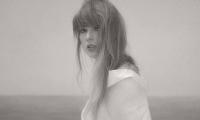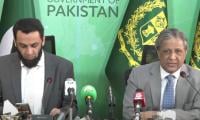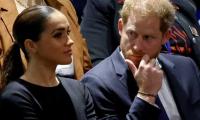The Canvas Gallery is hosting Abdullah MI Syed’s solo art exhibition titled ‘Cut from the Same Cloth’ until February 27. This is the Sydney-based artist of Pakistan origin’s third solo presentation at the gallery.
Quoting Dr Matt Cox — who has published internationally on Asian art and architecture and is the curator of Asian Art at the Art Gallery of New South Wales, Sydney, Australia — the gallery’s statement reads:
“The exhibition is crafted as a modest exploration of Syed’s fibre use in his contemporary art practice. Since 2000 Syed has experimented with the conceptual, natural and material connections of fibre in paper and fabric, as both materials are part of organic processes.
“The exhibition brings together his earlier and newly crafted works and gives a snapshot of how Syed articulates commonalities that paper and fabric share while bridging the conceptual and theoretical gap between art and craft.
“The artwork in this exhibition is made out of banknotes and fabric that creates new geo-political narratives, archives and histories. The use of national flag colours, icons, textile, decommissioned shredded banknotes and hand-cut uncirculated banknotes investigate subjects like identity politics, nationalism, capitalism, migration and religion.
“Syed recreates abstracted and hybrid images of portraits, cities, architecture and nature. Each piece is part of the same cloth that is cut into pieces — distorted, erased and re-fabricated in the name of profit, politics and power.
“Syed’s meticulous woven tapestries, reliefs, garments and stitched textiles have brought about dense, multifaceted objects, some of which he created with the assistance of local craftsperson from countries such as the USA, Pakistan, Bangladesh and Australia.
“Syed recognises the cross-cultural craftsmanship of stitching and weaving as mark-making; a way of signifying social agency as well as suggesting an unravelling of his own displacement, and personal biography.
“Syed’s multidisciplinary and multivalent art practice speaks to contemporary conditions while resonating with earlier and geographical diverse episodes in art history. From the Russian Constructivists to the geometric abstraction of minimalism and Islamic art, one observes in Syed’s work a paring back to essential forms and a dedication to surface and rhythm that is both formal and ideological.
“He has long been interested in the connection between paper and fabric, in particular the cross-hatching fibres, carefully woven in the weft and warp that intersect across the horizontal and vertical axis of the material plane giving it its form and strength.
“The strength and simplicity of this structure is fascinating to Syed, whose techniques of production are integral to his vision. If one were to imagine a metaphorical schema to describe Syed’s methods and his mode of thinking, one need not look further than the grid.
“While ruminating on what he sees as the inseparable and yet often antagonistic entanglements of nation, religion and capitalism, Syed invokes the grid to find remission and comfort in the suspended spaces between the lines and hope in the moments of concurrence.
“Complementary to his intellectual engagement with the theory of conceptual art and his cerebral commitment to the grid, Syed’s work is grounded in a dedication to craft that announces a return of the hand.
“This love of craft stems from childhood moments watching his mother stitching, sewing and embroidery and it is this lived experience of craft that has inspired Syed to continue to learn and collaborate with craftspeople in the USA, Australia, Bangladesh and Pakistan.
“The woven and stitched cloths and the carefully folded paper exemplify a seamless relationship between cognitive thinking and creative activity that prompts further questions about the relationship between an object and its image.
“Syed’s earlier works ‘Flagging I and II’ (2005), for example, emulate their store-bought counterparts and appear as a deliberate gesture to the ready-mades of American pop artists like Andy Warhol and Jasper Johns.
“But like John’s paintings of the American flag, Syed’s remakes of the ready-made Indian, Bangladeshi and Pakistani flags complicate the relationship between object, image and ideology.
“As noted by [Scott] Wark, ‘Flags are slippery. Their superficial simplicity and blunt surety belie a deep symbolic indeterminacy. Once struck, their silken forms are responsive to the subtlest political changes. The paradoxes of identity and the complexities of history gather in their gentle, rippling folds.’
“In the ‘Cut from the Same Cloth’ (2020) installation series, the various national flags are respectively presented and replete with their national anthems but offer something more than the rehearsed mythologies of the nation.
“In the ‘Qaumi Taranah’ — also known as ‘Pak Sarzamin’ — version, the green of the Pakistani flag embroidered with the national anthem is simultaneously obscured and enhanced with white spaces (which signify marginalised communities) and promises the possibility of inclusion.
“The red and blue stripes, while nodding to America and Australia — Syed’s two adopted countries — refer to internal and external conflicts in a world where the future of democracy is unclear.
“Installed in the gallery space, the new hybrid flag is transformed. Leaning rather than flying, folded rather than taut, it is unburdened of its political purpose and is rendered as textile.
“The complicated semiotics of its colours, for now lying dormant, are dissolved into harmonious composition and the proscriptive conditions of the formal texts are abstracted into decoration and pattern.
“Syed has found a connection between text and textile and used weaving to create a language of sculpture that finds affinity with the contemporary American artist Richard Tuttle, who like Syed works with both fabric and paper.
“Syed’s training in drawing and printmaking has helped him develop a sensitivity to the medium of paper and its potential as both a surface to be marked and a material to have been sculpted into three-dimensional form.
“With a strong understanding of its density and its propensity to record impressions, Syed scores, cuts, folds and glues paper to form reliefs and sculptures of different scale and experience.
“Fascinated by the idea of wormholes as articulated by Einstein and Nathan Rosen, in the ‘Weaving Overlapped Realities’ (2020) and ‘Weaving Myths’ (2013-2020) series, Syed conceived his new banknotes as speculative structures linking disparate points in space and time.
“Folded upon themselves, the notes — not unlike the flags — bring unlikely and even antagonistic entities into proximity. On either side of a single plane are opposing political figures, structures and scenes from different geographies and time zones.
“When the note is folded back on itself, the two figures and architectures are brought together, face to face, where they inhabit the same space and time. Likewise the interlaced notes bring into contact American President Abraham Lincoln and Mao Zedong, and the United States Capitol and Great Hall of People in Beijing.
“On another note, Muhammad Ali Jinnah, Pakistan’s first Governor General, meets Queen Elizabeth, Mahatma Gandhi and the White House in Washington DC as well as Badshahi Mosque in Lahore.
“Syed’s series ‘Fabricated Economies’ (2020) emerged in assistance with Adelaide weaver Janet Maughan and a chance opportunity. In 2016 Syed stumbled on a lot of shredded decommissioned US dollar bills in a local Sydney auction house.
“Their deconstructed form, appearing as strands, threads or fibres, appealed to Syed, whose natural instinct led him to reweave them into a size and shape similar to their original.
“However, the original note, having its value corrupted, could not be reconstituted, instead the weaving process reveals acts of erasure, discontinuity and revaluation. For Syed, his new woven tapestries or miniature rugs are fabricated objects of desire that speak to emotional and economic realities that we all are tied to.
“By repurposing flags, anthems and banknotes Syed transforms the economies of power into what he refers to as an ‘economy of poetic activism’.
“Through drawing, stitching, weaving and folding, Syed makes visible the gaps between the heeds that draw out intrinsic vulnerabilities. “While brought forth through an attention to materials, such moments of unknowing are openings that invite the wandering of memory and meditation on things beyond the material.”
— Photo courtesy: Canvas Gallery
An aerial view of Karachi city. — AFP/FileCelebrating ShakespeareThe National Academy of Performing Arts is...
A representational image showing people taking part in a plantation drive in Pakistan. — UNAP website/FileKARACHI:...
A representational image of a gavel in a court. — Unsplash/FileAn anti-terrorism court has issued bailable arrest...
Two employees while working on a gas pipeline in an unidentified location. — AFP/FileThe SSGC disconnected gas...
Murtaza Bhutto brother of the then prime minister and Pakistan Peoples Party chief Benazir Bhutto . — Facebook/Mir...
CEO, KWSC Engineer Syed Salahuddin Ahmed pose for a photo at the KWSC office this image was released on March 12,...







